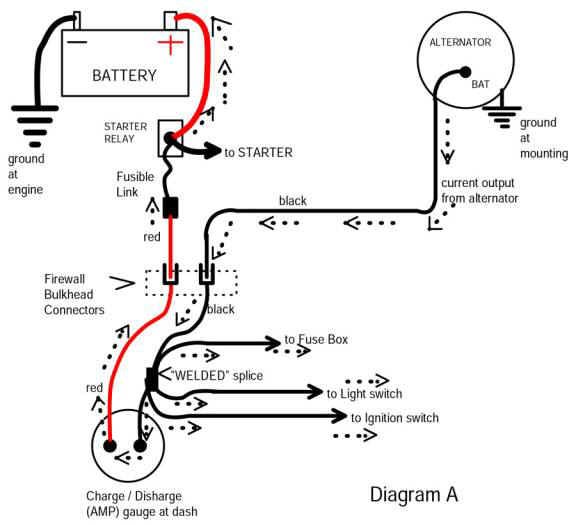over charge
EDIT....................N' I see I was typing as 68 posted, LOL
This is easy. It's known as "voltage drop." ANY wire, and in this case a combination of wires and connections is in reality a RESISTOR. The more CURRENT you put though that resistor, the more voltage drop you have, and the more RESISTANCE you have, the more drop you have. Resistance is caused by undersize wire (or in other words an oversized alternator on factory wiring) and it's mostly caused by BAD CONNECTIONS at the bulkhead connector, the ammeter, and in more rare cases the factory welded splice. This is a big splice in the black ammeter wire up under the dash.
Here read this article:
http://www.madelectrical.com/electricaltech/amp-gauges.shtml
On that page is this simplified diagram I reposted below:
Follow from the alternator, first there may be a bad connection right at the alternator, that is, the ring terminal itself may be deteriorated. Very likely, however, the worst of the problem is where the black goes in through the bulkhead on it's way to the ammeter, first passing the "welded splice". The ammeter itself can have internal problems, loose connections at the ammeter studs, and again, deterioration inside the wire ring terminals. Then, back out the bulkhead connector once more (on the red) so one MORE potential bad connection, and last, the fuse link could be deteriorated.

Also, the voltage difference you read between alternator and battery is going to depend on whether the battery is "down," what accessories are turned on, and therefore how much the alternator is charging. If the battery is "normalized" all up, and no accessories, the ammeter SHOULD be running really close to "zero" (middle) and you should not see much difference in voltage
EDIT....................N' I see I was typing as 68 posted, LOL
This is easy. It's known as "voltage drop." ANY wire, and in this case a combination of wires and connections is in reality a RESISTOR. The more CURRENT you put though that resistor, the more voltage drop you have, and the more RESISTANCE you have, the more drop you have. Resistance is caused by undersize wire (or in other words an oversized alternator on factory wiring) and it's mostly caused by BAD CONNECTIONS at the bulkhead connector, the ammeter, and in more rare cases the factory welded splice. This is a big splice in the black ammeter wire up under the dash.
Here read this article:
http://www.madelectrical.com/electricaltech/amp-gauges.shtml
On that page is this simplified diagram I reposted below:
Follow from the alternator, first there may be a bad connection right at the alternator, that is, the ring terminal itself may be deteriorated. Very likely, however, the worst of the problem is where the black goes in through the bulkhead on it's way to the ammeter, first passing the "welded splice". The ammeter itself can have internal problems, loose connections at the ammeter studs, and again, deterioration inside the wire ring terminals. Then, back out the bulkhead connector once more (on the red) so one MORE potential bad connection, and last, the fuse link could be deteriorated.

Also, the voltage difference you read between alternator and battery is going to depend on whether the battery is "down," what accessories are turned on, and therefore how much the alternator is charging. If the battery is "normalized" all up, and no accessories, the ammeter SHOULD be running really close to "zero" (middle) and you should not see much difference in voltage